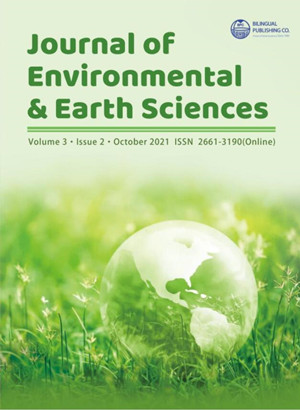
Sequential Damming Induced Winter Season Flash Flood in Uttarakhand Province of India
DOI:
https://doi.org/10.30564/jees.v3i2.3069Abstract
204 persons were killed while two hydropower projects located in close proximity at Rishiganga (13.2 MW), and Tapoban (520 MW) were damaged in Dhauliganga flood of February 7, 2021 in the Indian Himalaya. This incidence occurred during the winter season when the discharge of the glacier fed rivers is minimal, and no rain was experienced in the region around the time of the flood. Despite discharge of the main river, Rishiganga, not involved in the flood due to damming upstream of its confluence with Raunthi Gadhera, based on field evidences massive volume of around 6 million cu m water involved in this flood is attributed to sequential intermittent damming at three different places; (i) Raunthi Gadhera was dammed first in its upper reaches, (ii) Rishiganga river was then dammed to the north of Murunna, and (iii) finally Dhauliganga river was dammed around Rini village to the upstream of its confluence with Rishiganga river. Lacking warning system only enhanced the flood-induced devastation. Legally binding disaster risk assessment regime, together with robust warning generation, and dissemination infrastructure are therefore recommended for all major infrastructure projects.Keywords:
Himalaya; Uttarakhand; Flash flood; Landslide dam; Landslide lake outburst flood (LLOF); Dam breachReferences
[1] J. Xu, R.E. Grumbine, A. Shrestha, M. Eriksson, X. Yang, Y. Wang, A. Wilkes. The melting Himalayas: Cascading effects of climate change on water, biodiversity, and livelihoods. Conservation Biology, 2009, 23(3): 520-30.
[2] V.P. Tiwari, R.K. Verma, K.V. Gadow. Climate change effects in the Western Himalayan ecosystems of India: Evidences and strategies. Forest Ecosystem, 2017: 4-13.
[3] T.P. Sabin, R. Krishnan, R. Vellore, P. Priya, H.P. Borgaonkar, B.S. Bhupendra, A. Sagar. Assessment of Climate Change Over the Himalayas. Springer Singapore, 2020: 207-222.
[4] Piyoosh Rautela. Lessons learnt from June 16/17, 2013 disaster of Uttarakhand, India. In: R. Shaw, K. Shiwaku and T. Izumi (eds) Science and Technology in Disaster Risk Reduction in Asia. Academic Press, 2018. http://dx.doi.org/10.1016/B978-0-12-812711-7.00017-1
[5] S. Khanduri. Formation and failure of natural dams in Uttarakhand Himalaya: An observation from Lwarkha, Chamba tehsil of Tehri Garhwal district, India. International Journal of Earth Sciences Knowledge and Applications, 2021, 3(1): 12-22.
[6] Piyoosh Rautela, R.K. Pande. Traditional inputs in disaster management: the case of Amparav, North India’. International Journal of Environmental Studies, 2005, 62(5): 505-515.
[7] V.K. Pandey, A. Mishra. Causes and Disaster Risk Reduction Measures for Hydrometerological Disaster in Uttarakhand, India: An Overview. International Journal of Current Research in Science and Technology, 2015, 1 (3): 61-80.
[8] S. Prakesh. Some socio-economically landslides in Uttarakhand Himalaya: Events, consequences and lessons learnt. In: H.K. Nibanupudi and R. Shaw (eds) Mountain Hazards and Disaster Risk Reduction, Springer, 2015: 1-271.
[9] S. Prakesh. Geo-environmental Characteristics, Natural Resources and Disasters in Uttarakhand State. Retrospect and Prospects of Natural Resource and Disaster Management in Uttarakhand Himalaya, 2014: 51-99.
[10] National Disaster Management Authority (NDMA). National Disaster Management Guidelines - Management of landslides and snow avalanches. National Disaster Management Authority, Government of India, New Delhi, 2009.
[11] K.S. Gulia. Discovering Himalaya: Tourism of Himalayan Region. ISHA Books, Delhi, 2007.
[12] V.C. Thakur. Landslide Hazard Management and Control in India’. International Centre for Integrated Mountain Development Kathmandu, Nepal, 1996: 1-43.
[13] M.P.S. Bisht, M. Mehta, S.K. Nautiyal. A report on geomorphic hazards around Badrinath Area (Uttaranchal) and innovative control measures proposed. NDBR Project Report, Department of Geology, HNB Garhwal University, Uttarakhand, 2002.
[14] M.P.S. Bisht, M. Mehta, S.K. Nautiyal. Impact of depleting glaciers on the Himalayan biosphere reservea case study of Nanda Devi Biosphere Reserve, Uttarakhand Himalaya’. In M.P.S. Bisht and D. Pal (eds) Mountain Resource Management: Application of Remote Sensing and GIS. Transmedia Publication, Srinagar, Uttarakhand, 2011: 17-31.
[15] D. Petley. The catastrophic landslide and flood in Chamoli in Uttarakhand: the sequence of events. The Landslide Blog, AGU Blogosphere, 2021. blogs.agu. org/landslideblog/20.
[16] A.B. Shrestha, J. Steiner, S. Nepal, S.B. Maharjan, M. Jacksom, G. Rasul, B. Bajracharya. Understanding the Chamoli flood: Cause, process, impacts, and context of rapid infrastructure development. ICIMOD, Nepal, 2021. https://www.icimod.org/article/understanding-the-chamoli-flood-cause-process-impacts-and-context-of-rapid-infrastructure-development/
Downloads
How to Cite
Issue
Article Type
License
Copyright © 2021 Author(s)

This is an open access article under the Creative Commons Attribution-NonCommercial 4.0 International (CC BY-NC 4.0) License.







 Piyoosh Rautela
Piyoosh Rautela





